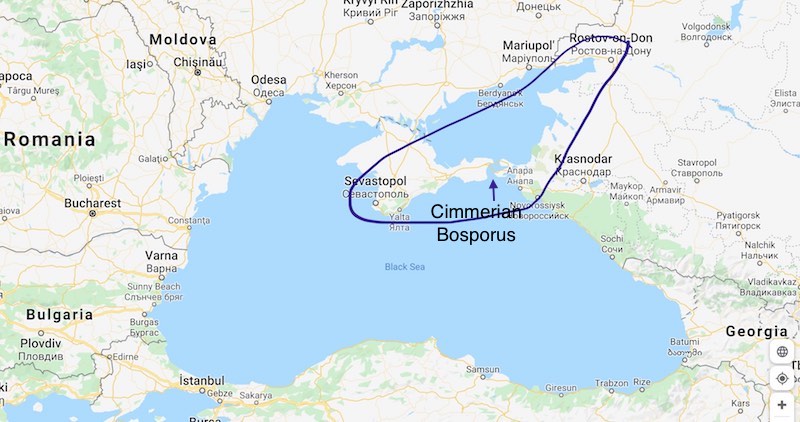 Coins of the Kingdom of the Bosporus,
Coins of the Kingdom of the Bosporus,
c. 26 BCE to 341 CE.
The kingdom covered the region encircled on the map, part of "the north Black Sea region." In 26 BCE Augustus appointed Ptolemo I King of the (Cimmerian) Bosporus and its long relationship with Rome as a client kindom began. (Do not confuse the location of this Bosporus with the Bosporus strait at Istanbul/Constantinople.) For over 350 years many of the coins had a Roman emperor on one side and the King of the Bosporus on the other. They are the longest lasting "Roman provincial" coins, issued until about 341, more than 40 years after all other provincial coinages had ceased. After Nero the Roman emperor is no longer named on the coins, but many are explicitly dated and often the name of the emperor can be deduced.
What's new? 2024, Sept. 8: Coins images linked to their enlargements. Simply click on the images.
The key reference is An Introduction to the History and Coinage of the Kingdom of the Bosporus, by David MacDonald, 2005. Other reference works are given below.
Dates. In the second century CE and later many coins of Kingdom of the Bosporus have explicit dates according to their own era. To convert to CE dates, take their date (which is in Greek) and subtract 297. For example, this coin has date BΞΦ below (= 2+60+500 = 562 = 265/6) and the bust is therefore of Gallienus.
Denominations: Some are marked "12" ("IB" in Greek), some "24" ("KΔ"), and many "48" ("MH").
Two Busts. Many coins have busts on both sides, usually a Roman emperor and the King of the Bosporus. Rarely are the Roman busts on AE executed well enough to recognize (although some are on electrum staters). In the third century when coins are explicitly dated, we can assign the name of a Roman emperor to his portrait if the date is right, but not because he is recognizable. For example, this coin has Trajan Decius on it, but you could not know from the portrait--we know it because he was Roman emperor in 250, to which year ZMΦ (= 7+40+500 = 547) of the Bosporan era corresponds (547-297 = 250).
 Polemo I, 36-8 BCE
Polemo I, 36-8 BCE
Struck 14-10 BCE
24-23 mm. 6.26 grams.
Lion running right with an eight-pointed star above his back which is very weak on this example.
Monogram includes "BAE".
This monogram has been the subject of much discussion, without resolution. The component letters seem pretty clear, but don't seem to make up the name of anyone or anything that might make a reverse type. The next coin has a somewhat similar monogram, but it is not clear what it is the monogram of.
MacDonald 230 (-1/=). The MacDonald image is only 21 mm. I imagine it was accidentally reduced.
Anokhin 257 (=/+1) is also imaged at 21 mm. However, many images in Anokhin are not accurately actual size (be careful about that).
Notes on Condition: The sides of the coins on this page are compared to the plate coins. / divides the sides. +1 means the coin here is slightly better on that side than the plate coin and +2 means significantly better. = means they would have the same value. -1 means the plate coin is slightly better and -2 significantly better.
Many coins of the Kings of the Bosporus are very skillfully tooled. It can be hard to tell whether one is tooled or not, or just smoothed, and even plate coins in major references are sometimes tooled. Often, when coins of Kings of the Bosporus are for sale, the waves in the hair may differ from a published example. Do they differ because the coin for sale is tooled, or because the published example is tooled, or because the dies were simply much different? All three cases are possible and happen. The lettering is often strengthened and the fields smoothed. I'd say some smoothing is close to normal in this series and it can be hard to confirm because many coin are struck with very flat fields--flatter than the fields of other ancient coins--so your feeling about whether it is "too flat" or not needs retraining to suit these issues. For example, look at the fields, lettering, and hair of this high-grade coin of Kotys II. The letters seem unusual, but not for this series. Look at this coin of Sauromates I. Is the hair, drapery, and dress of Nike tooled? They look quite a bit different from the two reference-work examples (which look quite a bit different from each other), but I don't see signs of tooling with a 8x jeweler's loop. Frolova has multiple pictures of most types and can help. Plate XI.6 is very similar with Nike's dress like this one (and unlike the other examples) and XI.8 has hair and bust like this one. It is not possible to judge whether a coin of the Kingdom of the Bosporus is "right" from a published example or two--the artistry and execution are so bad there is little consistency--unlike, say, the consistency of Roman imperial coins.

Aspurgus/Tiberius
Struck c. 35-37.
24-22 mm. 8.22 grams.
Head of Aspurgus right, monogram behind, IB (for 12) in front of neck.
Head of Tiberius right, laureate
KAIΣAPOΣ TIBEPIOY
MacDonald 300 (+2/+1). Anokhin 319 (+1/+1).
Note: Usually denominations are on the reverse. However, usually reverses are more concave, like the Tiberius side here. If it were not for the "IB", the Aspurgus side would be regarded as the obverse. Here I have put Tiberius on the reverse, like Anokhin and contrary to MacDonald.
,
 Aspurgus/Tiberius
Aspurgus/Tiberius
Struck c. 35-37.
21-20 mm. 8.08 grams.
Head of Aspurgus left, monogram retrograde behind, BI (for 12) in front of neck. Both the monogram and the denomination (which should be "IB") are retrograde.
Head of Tiberius right, laureate
KAIΣAPOΣ TIBEPIOY
MacDonald 301 variety (Aspurgus side retrograde) (+1/+1 compared to 300). Anokhin 319 but retrograde (+1/+1 compared to 319).
This coin is somewhat better on both sides than either of theirs.
This coin, like the one above, is pictured here with Tiberius as the reverse.
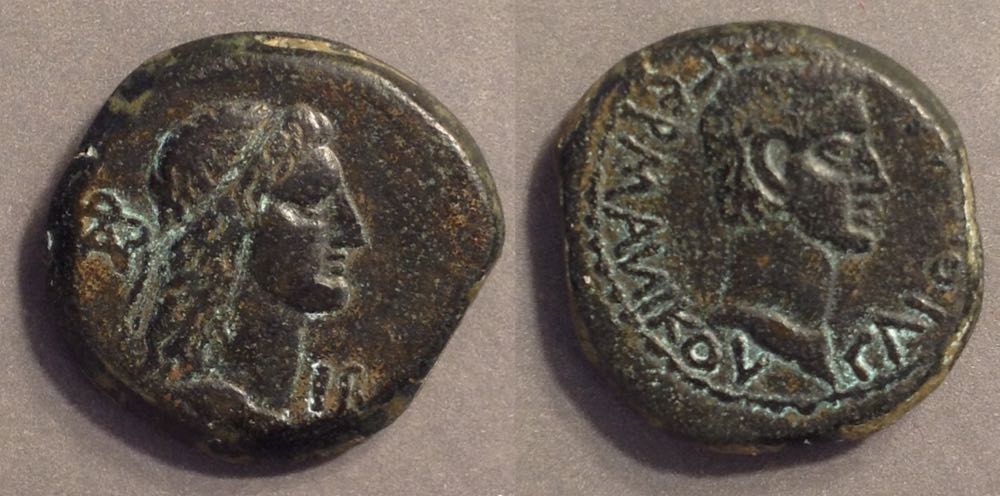 Aspurgus/Caligula
Aspurgus/Caligula
Struck 37/38
23-22 mm. Thick. 12.06 grams.
Head of Aspurgus right, diademed. IB before neck. Monogram behind including BAP.
Bare head of Caligula right
ΓAIOΣ KAIΣAPOΣ EPMANIKOY
MacDonald 302 (-2/=). Anokhin 320. (Same image)
This coin is pictured here with Caligula as the reverse.
Gepaepyris, 37/8 - 38/39 CE
24-23 mm. 8.36 grams.
Her bust right, draped
BACIΛICCHC ΓHΠAIΠPEΩC
Head of Aphrodite Apatura right, wearing calathus and veil. IB to right.
MacDonald 306 variety with "IB" to right instead of left (+3/+2, MacD's reverse is tooled). Anokhin 326. (Same image)
This coin is nearly flat, but very slightly more convex on the Gepaepyris side, as expected.
Mithradates III and Gepaepyris, 39-44 CE.
Struck 39-41
23 mm. 7.19 grams.
BACIΛEΩC MIΘPAΔATOV
Head right, diademed. Not bearded.
BACIΛICCHC ΓHΠAIΠVPEΩC
Draped bust of Gepaepyris rt., IB before neck.
MacDonald 312 (+2/+2). Anokhin 331. (Same image as MacDonald)
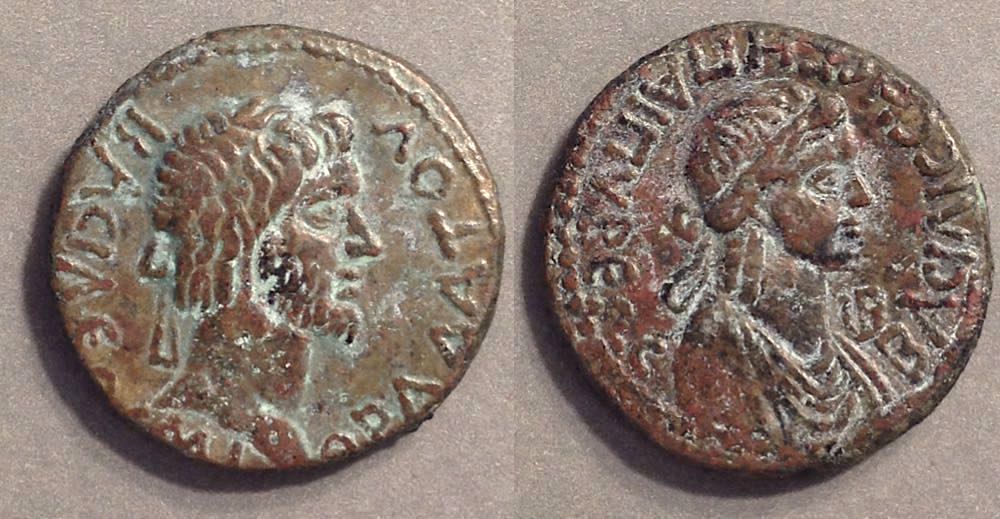
Mithradates III and Gepaepyris, 39-44 CE.
Gepaepyris was the wife of the previous ruler (Aspurgus) and step-mother of Mithradates III.
Struck 39-41
22 mm. 7.76 grams.
BACIΛEΩC MIΘPAΔATOV
Head right, diademed. Bearded.
BACIΛICCHC ΓHΠAIΠVPEΩC
Draped bust of Gepaepyris rt., IB before neck
MacDonald 312 (+1/+2). Anokhin 331. (Same image as MacDonald)
Theirs is not bearded. Theirs is like the previous coin.
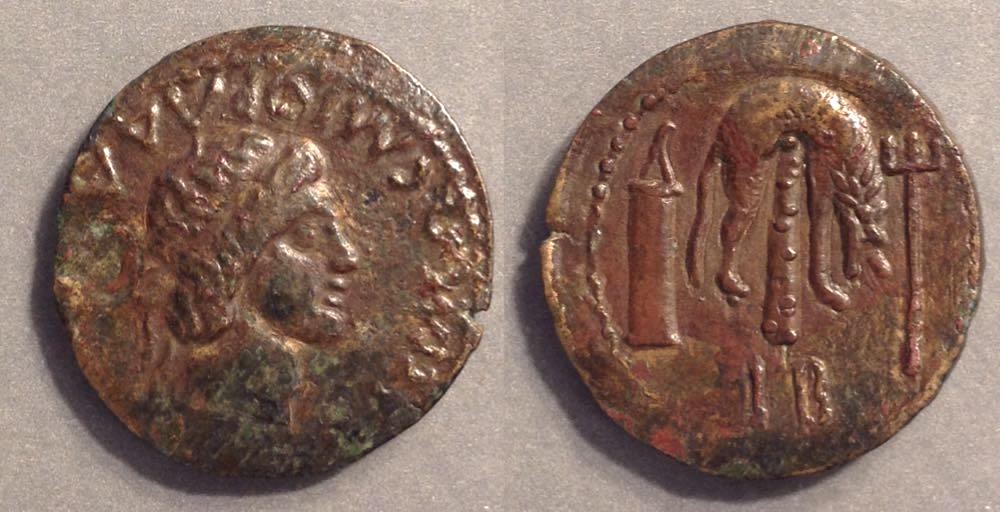
Mithradates III, 41-45
23 mm. 9.80 grams.
BACIΛEΩC MIΘPAΔATOV
Head right, diademed
Lion-skin draped over vertical club, quier to left and trident to right
IB below.
MacDonald 313 (-1/+1). Anokhin 330 (-2/=).
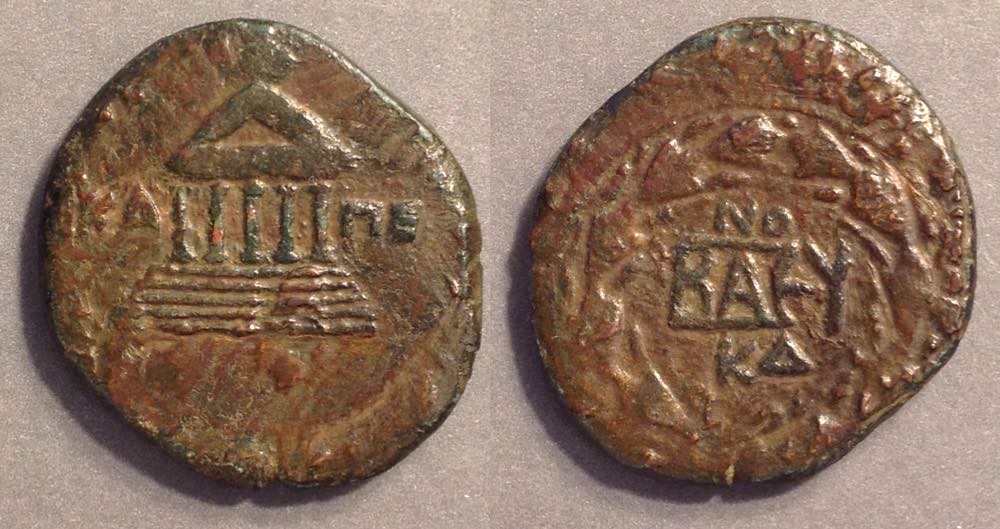 Eunice, Queen of Kotys I, 68-69, as ruler in her own name during the interregnum after his death.
Eunice, Queen of Kotys I, 68-69, as ruler in her own name during the interregnum after his death.
Struck 68-69
26-24 mm. 10.31 grams.
Temple with five columns, KΔ to left, ΠE to right, for "Capitolium, either that of Rome or a local Bosporan temple dedicated the home of Rome's chief deities." [MacD p. 65]
NO above and KΔ below monogram, all in wreath. BAEY (Basilia Eunice?)
("NO" might mean "noummia" 24 for the denomination, but Oliver Hoover doesn't think so in his review.)
MacDonald 337/1 "Bronze issue of Eunice, AD 68-69." (=/=) Anokhin 371. (Same image as MacDonald)
The MacDonald image measures only 22 mm and the Anokhin image 24 mm, significantly smaller than this coin.
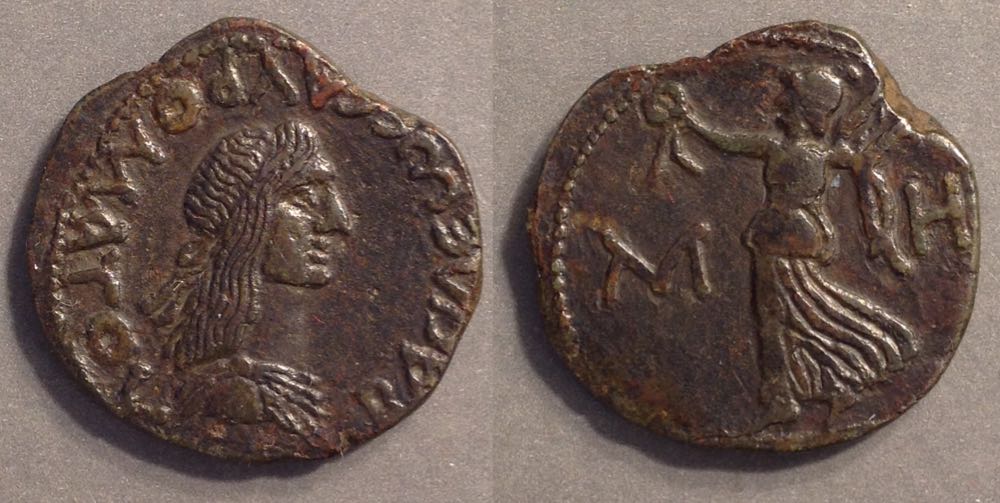 Sauromates I, 93/4-123/4.
Sauromates I, 93/4-123/4.
25 mm. 8.63 grams
Struck 108-118.
BACIΛEΩC CAYPOMATOY
His bust right, draped and diademed
Nike standing left with wreath and palm
M to left, H to right (for 48, the denomination)
MacDonald 397 (=/=). Anokhin 442 (=/=).
This coin has hair, cuirass, and Nike's dress much different from the two coins cited. That, and the bold hair and bold dress of Nike might raise concerns it is tooled. Nevertheless, Frolova Plate XI 6 is very similar with Nike's dress like this one (and unlike the other examples) and XI.8 has hair and bust like this one. Coins of the Kingdom of the Bosporus are very erratic in design details. If a coin does not look like the one in MacDonald, it may be fine anyway (or, maybe not).
 Sauromates I, 93/4-123/4
Sauromates I, 93/4-123/4
with countermark of Septimius Severus
26-25 mm. 7.34 grams.
BACIΛEΩC CAYPOMATOY
His bust right, draped and diademed
Nike standing left with wreath and palm
M to left, H to right (for 48, the denomination)
MacDonald 397 (=/=) with countermark. Anokhin 442 (=/-1) with countermark. This countermark is on MacDonald 543/2 (Sauromates II) from c. 90 years later. The countermark is on Frolova plate XXXVIII 8 and 10 (however, on reverses). Others also have a second, "B" countermark.
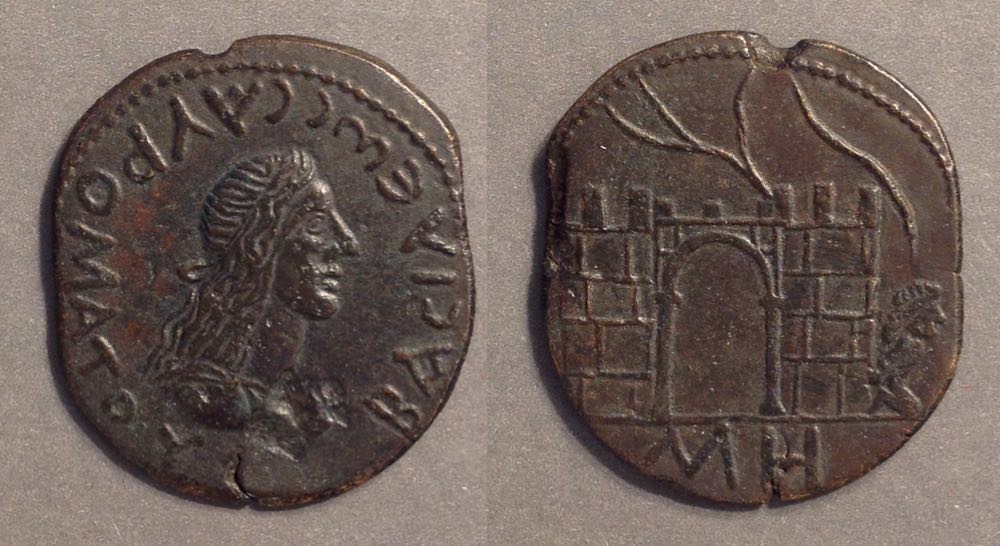
Sauromates I, 93/4-123/4
26-23 mm. 6.50 grams.
Struck 108-115.
BACIΛEWC CAYPOMATOY
His bust right, draped and diademed
Fortress wall gate, captive facing outward at right, wavy lines drifting upward (trees?)
M H in exergue (for 48, the denomination)
MacDonald 400/2 (+3/+3 compared to 400/1). 400/2 should say "Bust right" but fails to mention it. The image of 400/1 is of this basic type but bust left and with captive in front of the left side of the arch. Anokhin 461 (reverse image only, +4).
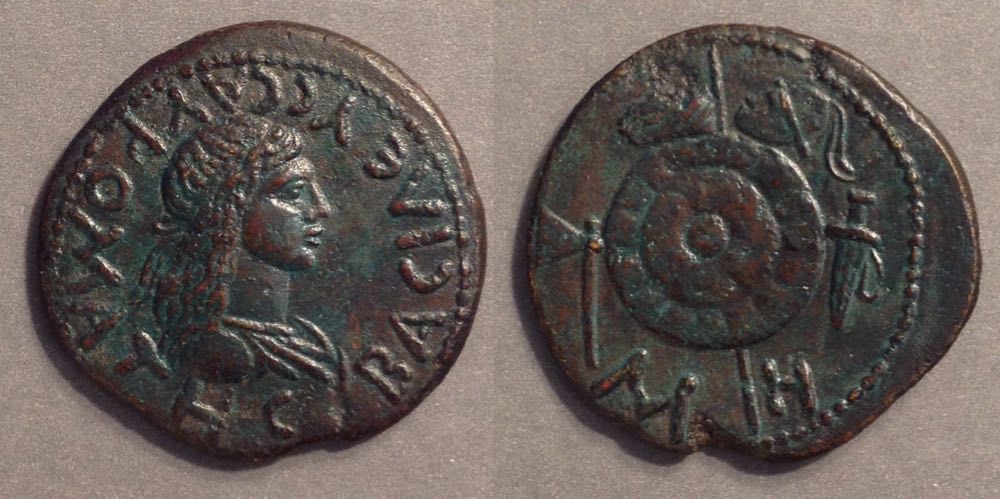
Sauromates I, 93/4-123/4
26-25 mm. 8.27 grams
BACIΛEWC CAYPOMATHC
His bust right, draped and diademed
Shield, spear behind, battle ax to left, sword to right, helmet at top right, horse's head at top left, M H in exergue.
MacDonald 401/1 (+3/+2). Anokhin 464 (+3/-1).
Sauromates I, 93/4-123/4
23-22 mm. 7.71 grams
Struck after 117
BACIΛEWC CAYPOMATOY
Curule chair, crown on it, shield and spear on left, human-headed scepter on right
Large MH in wreath
"must be associated with the investiture of Sauromates I which he received from Hadrian after that emperor's accession in 117 AD" [Frolova p. 29]
MacDonald 408/3 (+1/-1). Anokhin 456 (+1/-1).
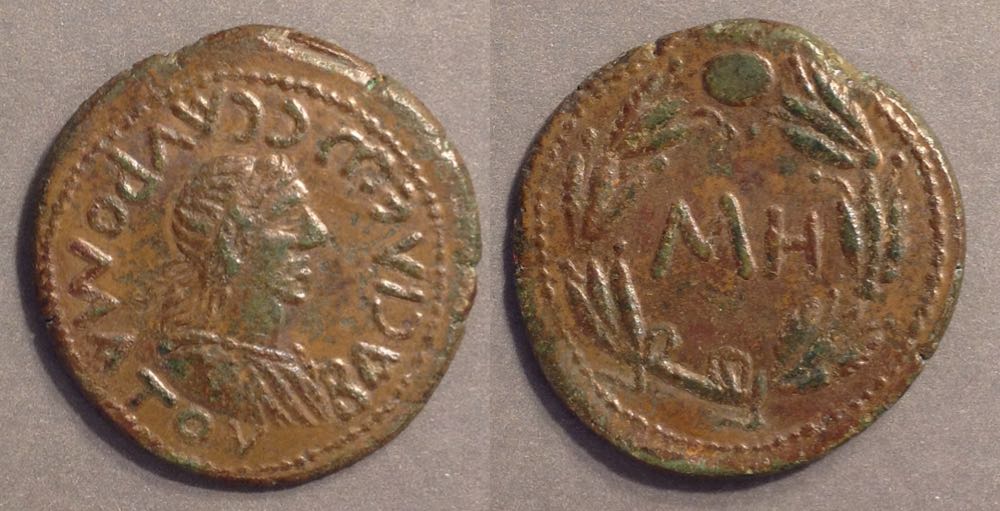
Sauromates I, 93/4-123/4
27 mm. 9.84 grams. Large.
BACIΛEWC CAYPOMATOY
His bust right
Large MH in wreath.
MacDonald 398/5 (+2/+1). Anokhin 454 (=/-1).
Kotys II, 124-133
24 mm. 7.72 grams
BACIΛEWC KOTYOC
His bust right, draped and diademed, trident before neck
Large MH in wreath
MacDonald 431 (=/=). Anokhin 500. (Same image. Anokhin 494 seems to be the same type.)
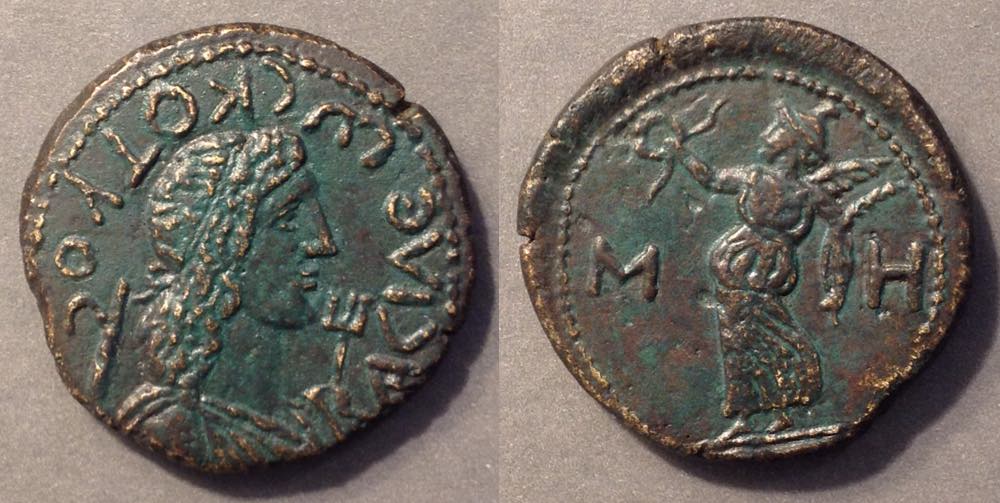
Kotys II, 124-133
24 mm. 10.86 grams
BACIΛEWC KOTYOC
His bust right, draped and diademed,
trident before neck, club behind
Nike standing left holding up wreath and palm
M H either side
MacDonald 434/3 (+1/+1). Anokhin 493. (Same image)
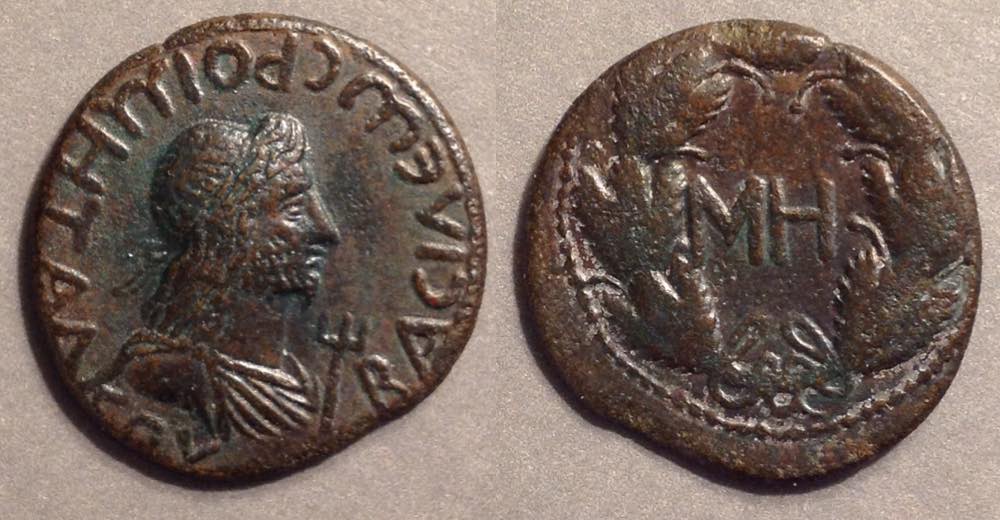 Rhoemetalkes, 133-154 (131/2 - 153/4 according to MacDonald)
Rhoemetalkes, 133-154 (131/2 - 153/4 according to MacDonald)
24-23 mm. 5.88 grams.
BACIΛEWC POIMHTAΛKOY
His bust right, draped and diademed, trident before
Large MH in wreath
MacDonald 454/2 (-1/-1). Anokhin 522 (+2/-1).
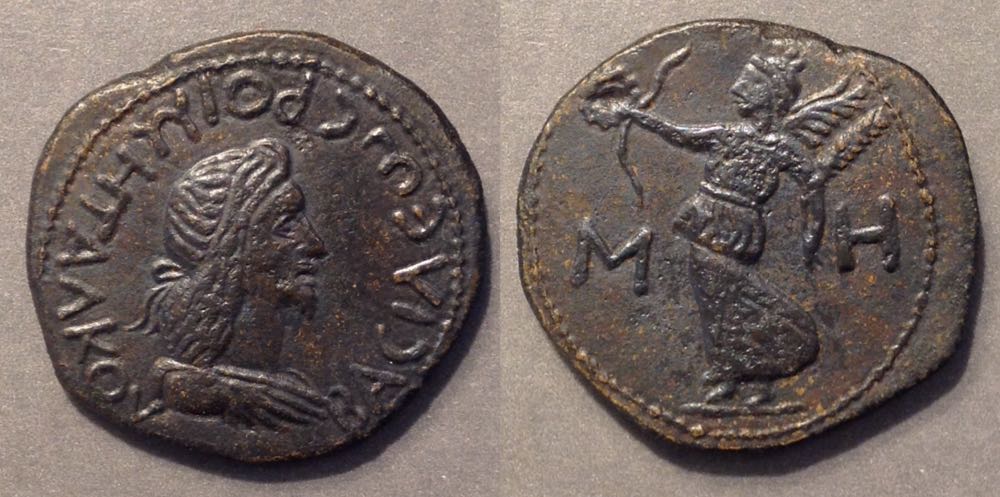 Rhoemetalkes, 133-154 (131/2 - 153/4 according to MacDonald)
Rhoemetalkes, 133-154 (131/2 - 153/4 according to MacDonald)
25 mm. 7.77 grams.
BACIΛEWC POMHTAΛKOY
His bust right, draped and diademed,
Nike standing left holding up wreath and palm
M H either side
MacDonald 455/1 (+2/=). Anokhin 520 (+2/+2) [image is only 23 mm]
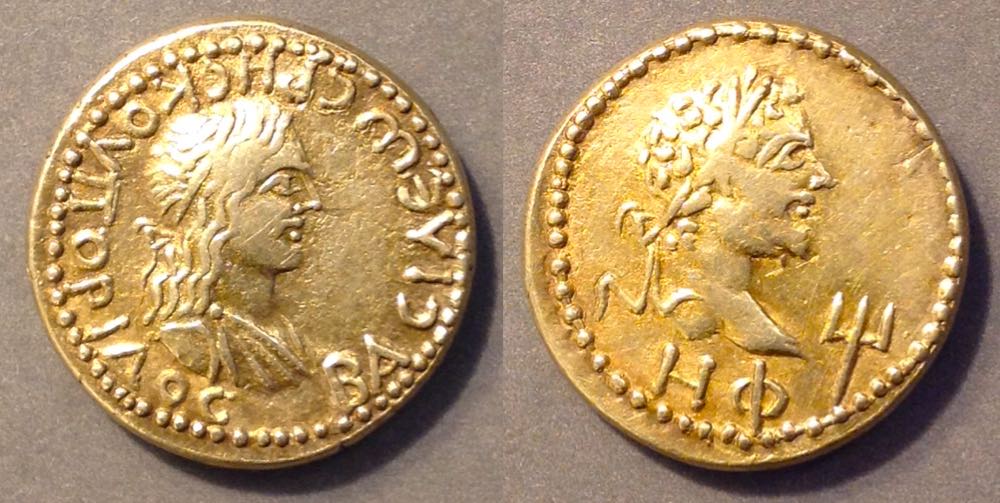 Rhescuporis II, 211-226 (Whether his number is II or III, he is the one with these dates.)
Rhescuporis II, 211-226 (Whether his number is II or III, he is the one with these dates.)
19 mm. Electrum. 7.69 grams.
BACIΛEWC PHEKOVΠOPIΛOC
His bust right, draped and diademed
Bust of Septimius Severus right, trident before
HΦ below (= year 508 = 211/212)
MacDonald 551/4 (-2/-2). Anokhin 628B (+2/=).
 Rhescuporis II, 211-226
Rhescuporis II, 211-226
24 mm. 9.57 grams.
BACIΛEWC PHEKOVΠOPIΔOC
His bust right, draped and diademed
King on horse pacing right, raising right hand
holding long transverse scepter in left.
Large * below
MacDonald 567/2 (-2/=). Anokhin 645 (-1/-1).
The region of the neck and bust is unusual on this coin. It does not show a cuirass, which the two reference coins do. Is it the result of tooling? Again, Frolova comes to the rescue. Plate L.33 has exactly this bust and may be a die match (although that coin is in much worse condition with very worn lettering, so it is hard to tell if they are die-identical.)

Rhescuporis II, 211-226
23 mm. 8.03 grams.
BACIΛEWC PHEKOVΠOPIΔOC
His bust right, draped and diademed
holding long transverse scepter in left.
Large * below
MacDonald 567/2 (-2/-2). Anokhin 645 (+1/-2)
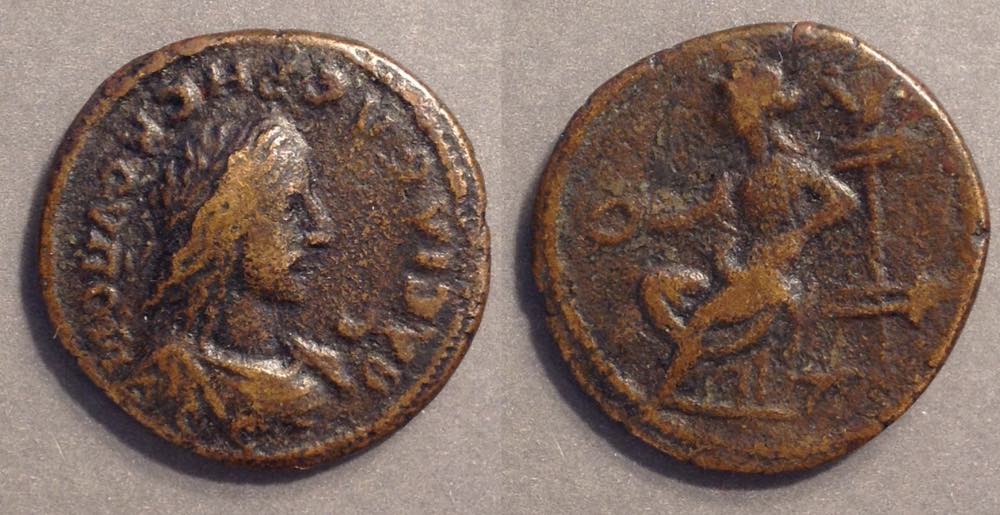
Rhescuporis II, 211-226
25 mm. 7.26 grams.
BACIΛEΩC PHEKOVΠOPIΔOC
His bust right, draped and diademed
Aphrodite seated left on throne with back, wearing mural crown
large * in lower right field.
MacDonald 572/1 (+1/=). Anokhin 649 (+2/+1)
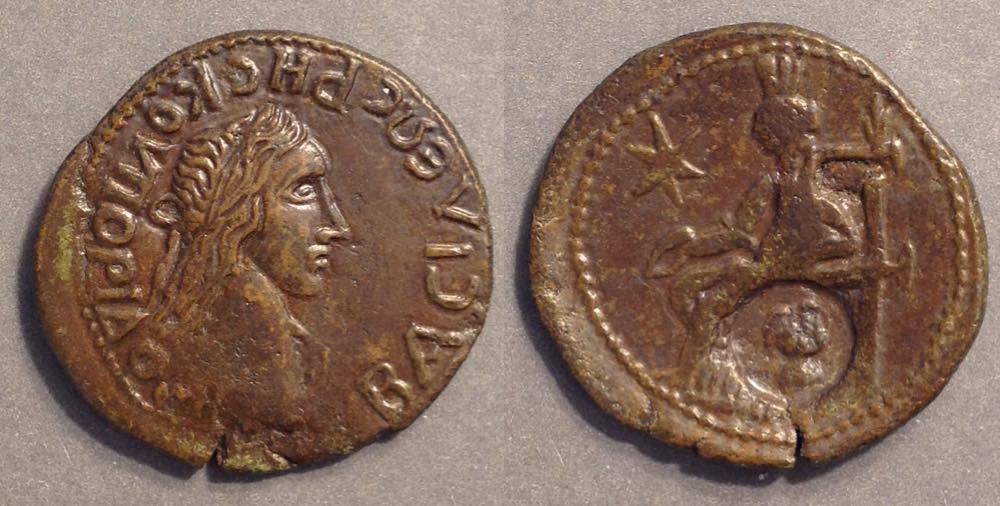
Rhescuporis II, 211-226
5 mm. 7.26 grams.
BACIΛEΩC PHEKOVΠOPIΔOC
His bust right, draped and diademed
Aphrodite seated left on throne with back, wearing mural crown
large * in upper left field.
Countermark (unidentified) on bottom of throne.
MacDonald 572/1 (no countermark) (+2/+1). Anokhin 649 (+3/+2).
Frolova LII.22 has a countermark much like this and said to be "head right," but not identified further.
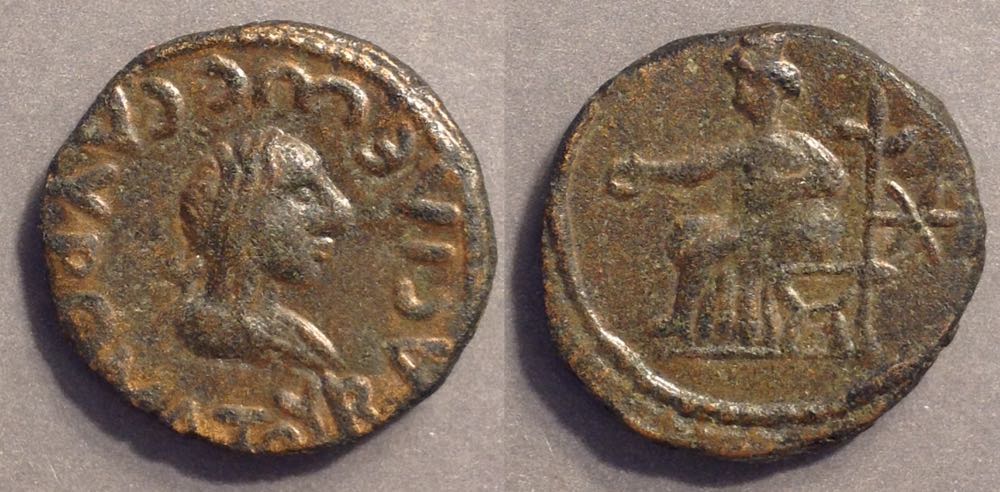
Sauromates III, 229-231
23 mm. 10.41 grams.
BACIΛEWC CAYPOMATOY
Crude bust right
Aphrodite seated left on curule chair, wearing mural crown
large * in field right
MacDonald 588/1 (+1/+1). Anokhin 668 (+1/+1).
Ininthimeus, 234-238
20 mm. 5.51 grams.
BACIΛEWC ININΘIM
Bust right of King vis-a-vas bust left of Aphrodite
Aphrodite seated left on chair, wearing mural crown
large * in field right
MacDonald 599 (+2/+1). Anokhin 679 (=/=).
The Anokhin image is 24 mm--larger than the coin.
Rheskuporis IV, 242-277 (Whether his number is IV or V, it is the one with these dates.)
20 mm. 7.09 grams.
BACIΛEΩC PHEKOΠOPIΛOC
[crude lettering and portraits]
Bust right, I before (Philip I)
ΓMΦ below (= year 543 = 246/7)
MacDonald 605 (no photo). Anokhin 694 (-1/-2).
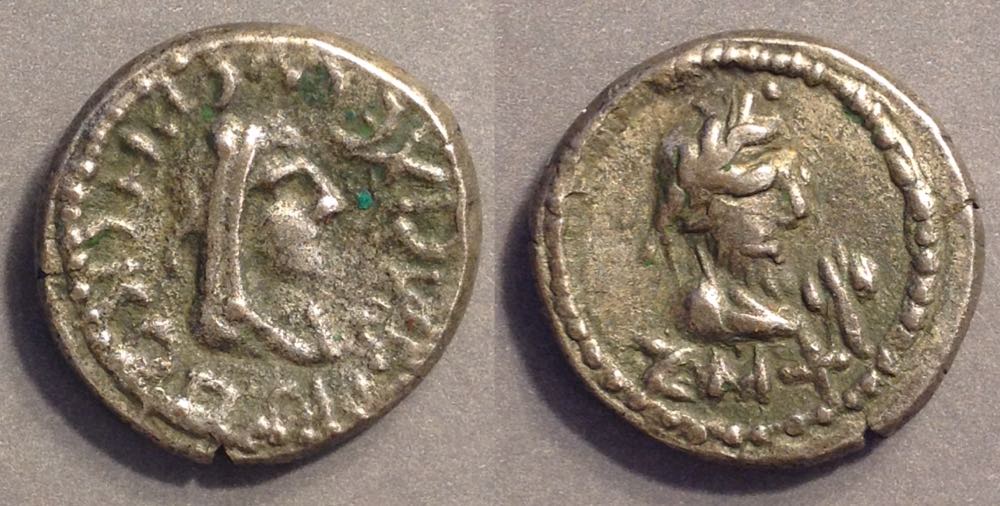
Rheskuporis IV, 242-277
19 mm. 7.44 grams. Base AR.
BACIΛEWC PHEKOΠOPΩN
His bust right, trident before neck
Bust right (Trajan Decius)
ZMΦ below (= year 547 = 250/1)
MacDonald 609/3 (No photo). Anokhin 698δ (=/+1).
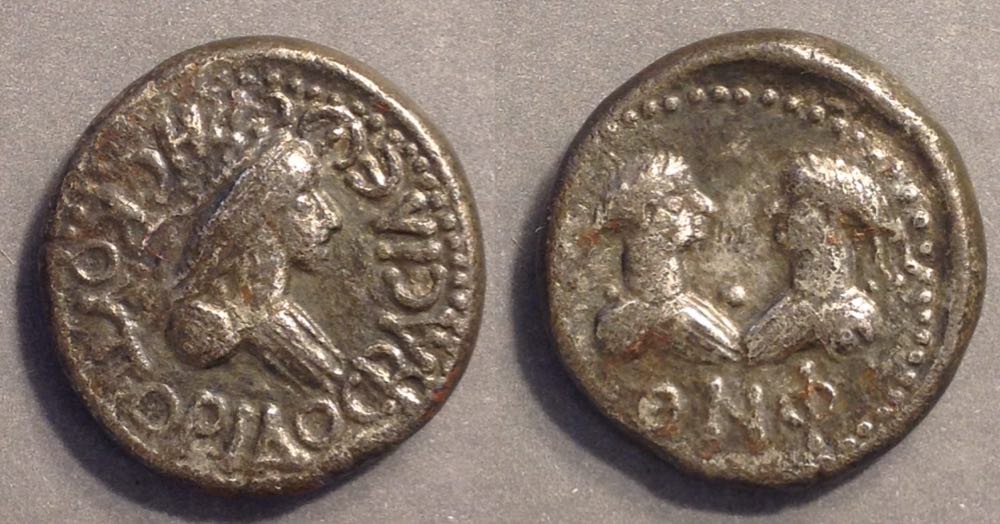
19 mm. 7.44 grams. Base AR.
BACIΛEWC PHEKOΠOPIΔOC
His bust right
Two busts vis-a-vis, Valerian and Gallienus
ΘNΦ below (558 = 261/2)
MacDonald 618 (=/=). Anokhin 707 (reverse photo only)(/-1)
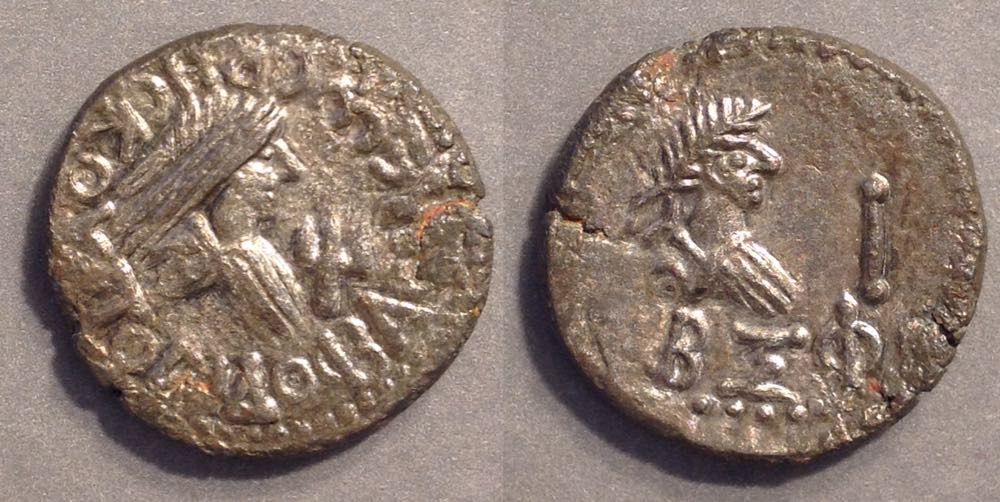
Rheskuporis IV, 242-277
21 mm. 6.90 grams. Base AR.
BACIΛEWC PHEKOYΠOPIΔOC
His bust right, trident to right
Bust right, I to right (Gallienus, as we call tell by the date)
BΞΦ below (= 562 = 265/6)
MacDonald 621 (=/= 620, only a different date). Anokhin 713 (=/=).
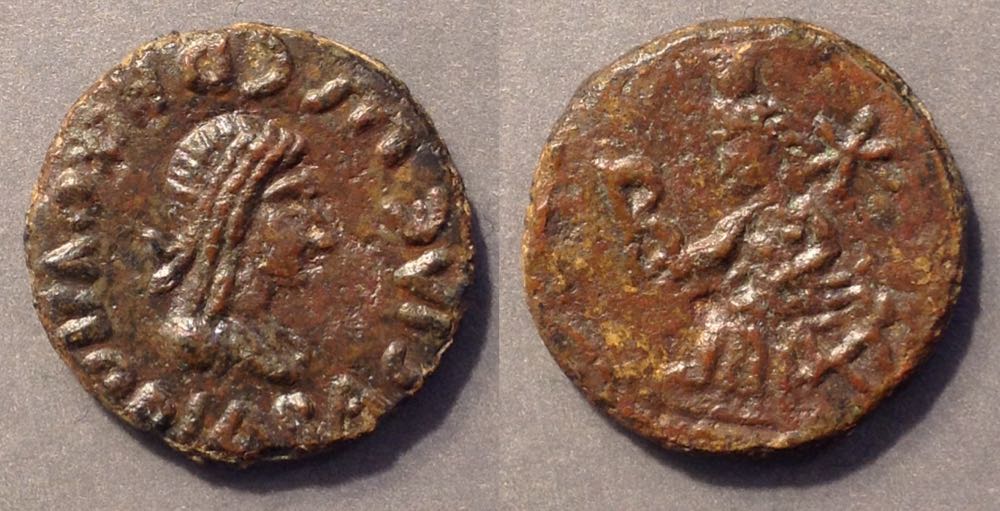
Rheskuporis IV, 242-277
19 mm. 5.60 grams.
BACIΛEWC PHEKOYΠΩPIΔOC
His bust right
Aphrodite Apatura seated left, holding apple(?)
large B in left field, * in right
MacDonald 626 (+3/+2). Anokhin 721 (+2/+1)
Rheskuporis IV, 242-277
15-14 mm. 4.19 grams. Poor metal.
Much abbreviated version of BACIΛEWC PHEKOYΠΩPIΔOC
His bust right
Aphrodite Apatura seated left, holding apple(?)
* in right
MacDonald 626/2 "the legends of the latest coins are illegible even on well-preserved specimens.... The standard of workmanship is extremely low." (No photo). Anokhin 722 (+1/-1)
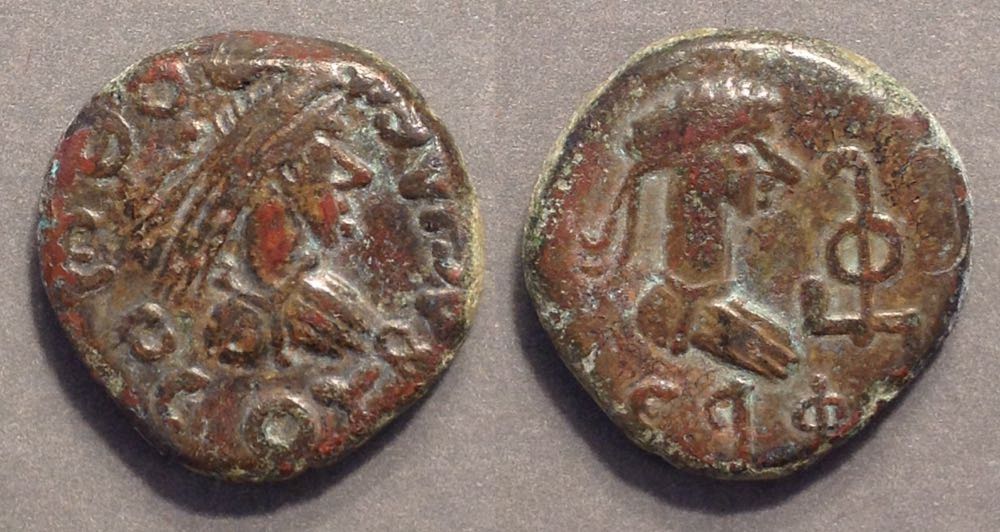
Thothorses, 285-308
19-18 mm. 7.46 grams.
Struck 296/7
BACIΛEWC ΘOΘWPCOY
His bust right
Bust right, tamgha before
EPΦ below, P retrograde (= 595 = 298/9)
MacDonald 644/2 (No photo) (+1/+1 compared to 637 with a different date). Anokhin 739 (+2/+1).
Thothorses, 285-308
20-19 mm. 8.41 grams.
BACIΛEWC ΘOΘWPCOY
His bust right
Bust right, tamgha before
EPΦ below, P retrograde (= 595 = 298/9)
MacDonald 646 (No photo. +1/+1 compared to 637 with a different date). Anokhin 743a (+1/=)
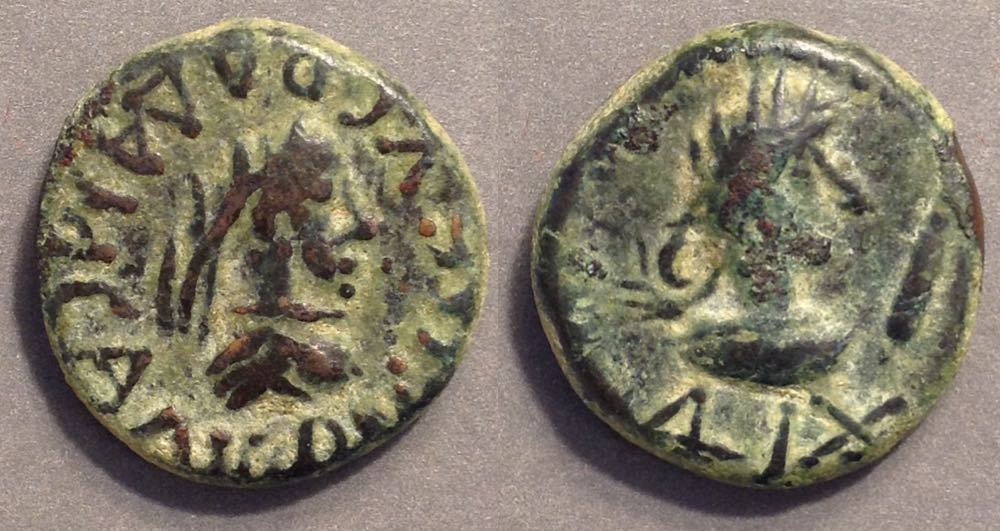
Rhadamsades, 309-319
19 mm. 7.60 grams.
BACIΛEWC PAΔAMCAΔ ..
His bust right
Bust right (Licinius?) club before
ΔIX below (= year 614 = 317/8)
[If it is AIX that would be year 611 = 314/5)
MacDonald 667 (+2/+1). Anokhin 762 (obverse only, -1)
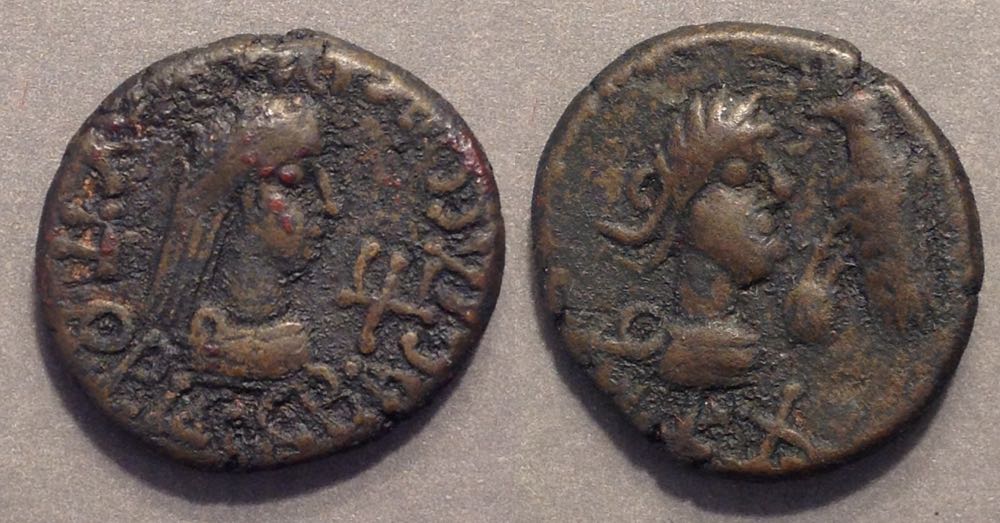
Rheskuporis V, 304-342 (Whether his number is V or VI, it is the one with these dates.)
With Constantine
21 mm. 7.35 grams.
Struck 324/5
BACIΛEWC PHEKOYΠOPIΔOC
His bust right, trident before
Bust right (Constantine) eagle on globe facing him
AKX below (= year 621 = 324/5)
MacDonald 680/3 (+1/=, compared to 680/2). Anokhin 771a (+1/=)
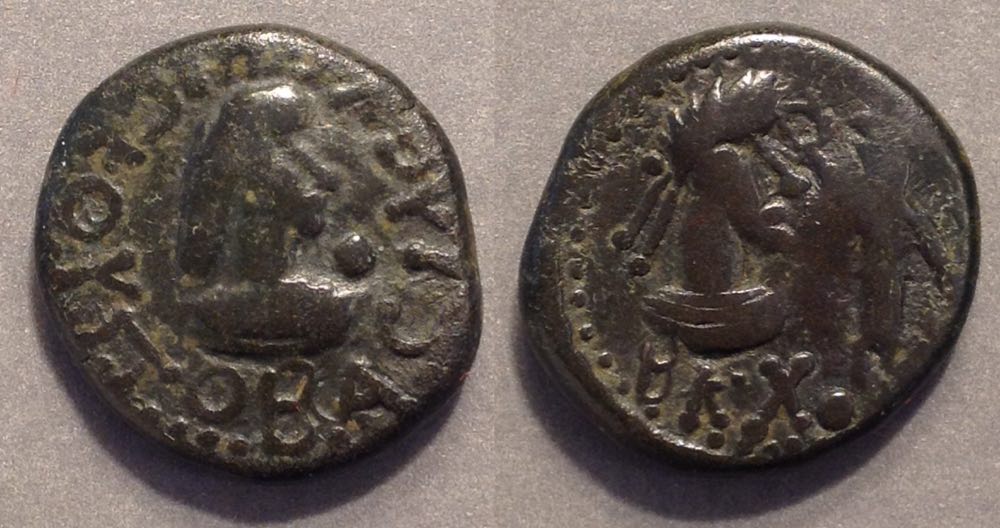
Rheskuporis V, 304-342
With Constantine
19-18 mm. 7.46 grams.
Struck 325/6
BACIΛEWC PHEKOYΠO
His bust right, globe before
Bust right (Constantine) Nike crowning him before
BKX below (= year 622 = 325/6)
MacDonald 681/4 (+2/=, compared to 681/1). Anokhin 771δ (+2/+2)
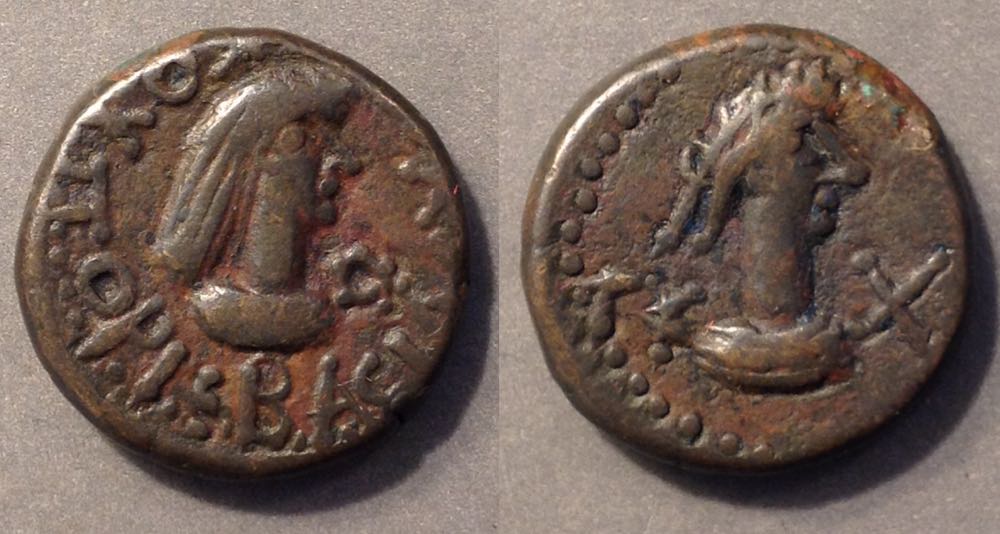
Rheskuporis V, 304-342
With Constantine
19 mm. 7.30 grams.
Struck 326/7
BACIΛEWC PHEKOYΠO
His bust right, globe before
Bust right (Constantine) Nike crowning him before
ΓK X across field (= year 623 = 326/7)
MacDonald 682/8 (no photo. +1/= compared to 680/2). Anokhin 774a (+1/+1).
Coins this late are crude. Coins continued until perhaps 638 which is 341/2, but dates after 633 (335/6) are rarely attested and so crude it is hard to be certain what date is intended.
Repeated Note: "+1" means the coin shown is slightly better than the plate coin. "-2" means significantly worse. Each side is evaluated separately.
References, in order of usefulness.
MacDonald, David. (2005) An Introduction to the History and Coinage of the Kingdom of the Bosporus, by David MacDonald. [This book attempts to be complete. It has many photos throughout. Almost all the types are illustrated. If a type was issued with several different dates it will be given several different numbers, but usually only one photograph.]
Anokhin, B. A. (1986) Coins of the Bosporus (in Russian) 1986 [This book attempts to be complete. 777 coins are photographed, the first 287 are from before Aspurgus. Many of the images are smaller or larger than life size. The weights are given, but you can not accurately tell the diameter of the coin from the image, although most are close and I didn't notice any more than 20% off.]
Frolova, N. A. (1979) The Coinage of the Kingdom of the Bosporus, A.D. 69-238, translated from the Russian by H. Bartlett Wells. BAR International Series 56, 1979. 126 pages of plates plus 4 of line drawings. This book is complete for this time interval. Often several coin images per type. This is very useful for showing the widely divergent appearances of different coins supposedly of one type. Two volumes, text and plates.
Alexeev, Vladimir and Peter Loboda. (2002) Antique and Medieval Coins of the Northern Black Sea Area, volume I, Regal Coins of the Bosporus. 323 enlarged photos, with short descriptions in both Russian and English. The photos are clear in B&W and the enlargements are appreciated, but the original sizes of the coins are not given, so it helps if you already know how large they are. There is a one-page introduction to the collection, but no text about the coins.
Stancomb, W. M. (2000) SNG XI The William Stancomb Collection of Coins of the Black Sea Region. Only plates XLV-XLIX, coins 961 through 1037 (77 coins).
Kovalenko, Sergei (2011) SNG State Pushkin Museum of Fine Arts: Coins of the Black Sea Region. Coins 1394 through 1868, all photographed, most with some glare. Their collection. There are many excellent electrum pieces. Many of the AE coins are in poor condition.
Zograph, A. N. (1977) Ancient Coinage: Part ii: The Ancient Coins of the Black Sea Littoral, translated from the Russian by H. Bartlett Wells. BAR Supplementary Series 33(ii). The last six page plates are of coins of the Kingdom of the Bosporus. Pages 306-340 discuss the coinage. This book has pages on the "BAE" monogram of the first coin above without coming to a clear conclusion about what is the monogram of.
Kasmanova, L. H. A book in Russian. I don't know how to read or translate the title, but the plates have coins of Kings of the Bosporous on the last seven plates.
Sear, David R. Greek Imperial Coins and Their Values: the Local Coinages of the Roman Empire. Seaby, 1982, p. 534-543, 95 coins and 27 images.
Hoover, Oliver. (2005) Review of MacDonald's book in the ANS magazine, volume 4.2, summer 2005, pages 59-62,
Note: SNG IX The British Museum 1 The Black Sea, does not cover the Kingdom of the Bosporus.
 Coins of the Kingdom of the Bosporus,
Coins of the Kingdom of the Bosporus, Coins of the Kingdom of the Bosporus,
Coins of the Kingdom of the Bosporus, Polemo I, 36-8 BCE
Polemo I, 36-8 BCE
 Aspurgus/Tiberius
Aspurgus/Tiberius Aspurgus/Caligula
Aspurgus/Caligula

 Eunice, Queen of Kotys I, 68-69, as ruler in her own name during the interregnum after his death.
Eunice, Queen of Kotys I, 68-69, as ruler in her own name during the interregnum after his death.


 Rhoemetalkes, 133-154 (131/2 - 153/4 according to MacDonald)
Rhoemetalkes, 133-154 (131/2 - 153/4 according to MacDonald) Rhoemetalkes, 133-154 (131/2 - 153/4 according to MacDonald)
Rhoemetalkes, 133-154 (131/2 - 153/4 according to MacDonald) Rhescuporis II, 211-226 (Whether his number is II or III, he is the one with these dates.)
Rhescuporis II, 211-226 (Whether his number is II or III, he is the one with these dates.)








